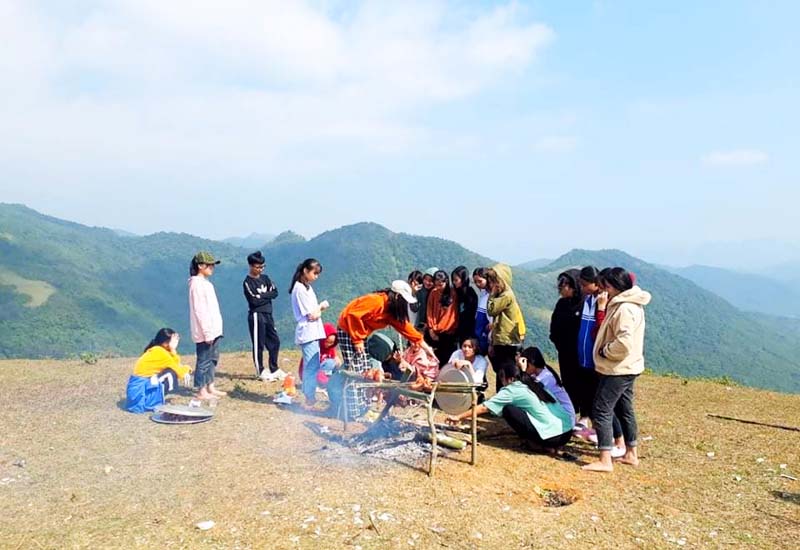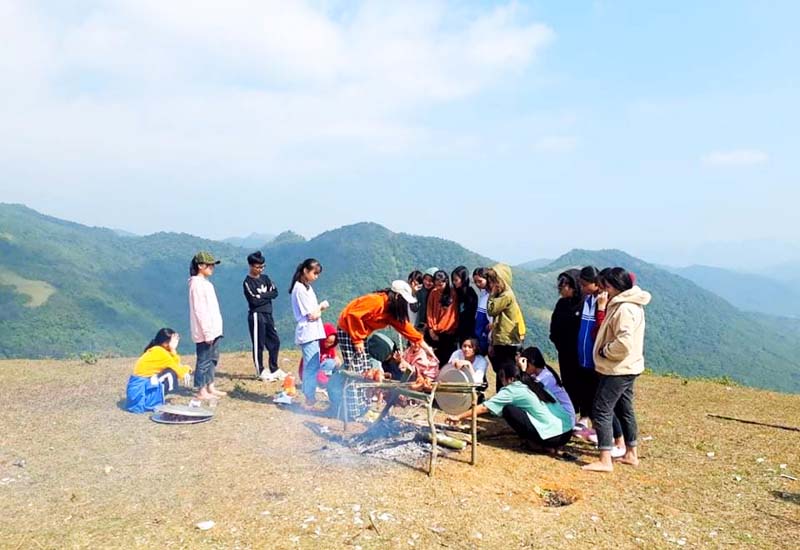
(HBO) - People can enjoy a bird-eye’s view of Dai Dong region from the vast U Bo Hill where the ground is covered with green grass and the weather is windy all year long.

U Bo Hill in Pheo Hamlet, Van Nghia commune (Lac Son) attracts a large number of visitors.
U Bo Hill is located in Pheo, one of the most disadvantaged hamlets in Van Nghia commune, Lac Son district. The hill has been part of the childhood memories of locals in Pheo Hamlet for generations as it was the place where they spent most of the time herding cattle and harvesting grass as a child.
People from nearby areas set their foot on the hill only after concrete roads leading there was constructed.
U Bo Hill is regarded as the roof of Cong Hoa as from there, people can take a panoramic view of the surrounding area, and even Kim Boi, almost 30km away, in clear days. Mountains in the distance in the communes of Quy Hoa, Tuan Dao, and My Thanh, as well as rice fields in Nhan Nghia and Tan Lap can also be spotted from there.
It was difficult to reach Pheo Hamlet before since it took about an hour to travel to the hamlet from the centre of Van Nghia commune, just 7km away. Now it only takes 15 – 20 minutes after roads were expanded and concreted.
As the name suggests, U Bo Hill consists of many scenic rolling hills with the one on the top, dominated by lesser spear grass, looking just like a cow’s hump ("u bo”).
After road infrastructure was improved, more and more people go to U Bo Hill for a picnic, said Bui Van Chinh, a resident of Pheo Hamlet. There were days when the visitors there reached almost one hundred, he said, adding that they came with foods, drinks and speakers to sing together and camp.
He further noted that it may be because with its high location, the hill has a fresh and cool climate.
From a remote mountainous hamlet, thanks to U Bo Hill, Pheo Hamlet has become a tourist attraction which is home to more than 80 Muong ethnic minority households, unique cultures and large terraced rice fields./.
Located just a 20-minute drive from Hoa Binh City, Ora Hill Farmstay & Glamping Hoa Binh is a captivating new destination nestled in Mo hamlet, Bình Thanh commune, Cao Phong district. Combining farming with leisure, this tranquil retreat is perfect for those seeking balance, joy, and an immersive experience in the expansive beauty of nature.
Muong Bi - Tan Lac is renowned as one of the four famous Muong regions in Hoa Binh province. Blessed by nature with a favourable climate and stunning landscapes, Tan Lac holds great advantages for tourism development. The local tourism industry has made remarkable strides in recent times thanks to the attention and support from the local authorities and sectors.
With its strategic location, well-developed transport network, and diverse soil and climatic conditions, Hoa Binh is emerging as a must-visit destination in Vietnam's northwestern tourism corridor. The province boasts numerous attractions, including the Kim Boi hot springs (Kim Boi district), the Dau Rong cave complex (Cao Phong), the Mai Chau valley (Mai Chau), and the iconic Hoa Binh hydropower plant.
The northern mountainous province of Hoa Binh has been listed among the 71 most beautiful places to visit worldwide by the prestigious US travel magazine Condé Nast Traveller.
Hoa Binh province’s rich natural and cultural resources position it as a prime location for developing community-based tourism (CBT). In recent years, support from central and provincial policies, as well as assistance from non-governmental organisations, have encouraged local ethnic minority and mountainous communities to actively engage in the sector.



 U Bo Hill in Pheo Hamlet, Van Nghia commune (Lac Son) attracts a large number of visitors.
U Bo Hill in Pheo Hamlet, Van Nghia commune (Lac Son) attracts a large number of visitors.